 Journal of Modern Physics, 2011, 2, 188-199 doi:10.4236/jmp.2011.24027 Published Online April 2011 (http://www.SciRP.org/journal/jmp) Copyright © 2011 SciRes. JMP Pedestrian Analysis of Harmonic Plane Wave Propagation in 1D-Periodic Media Pierre Hillion Institut Henri Poincaré, Le Vésinet, France E-mail: pierre.hillion@wanadoo.fr Received June 2, 2010; revised July 8, 2010; accepted July 10, 2010 Abstract The propagation of TE, TM harmonic plane waves impinging on a periodic multilayer film made of a stack of slabs with the same thickness but with alternate constant permittivity is analyzed. To tackle this problem, the same analysis is first performed on only one slab for harmonic plane waves, solutions of the wave equa- tion. The results obtained in this case are generalized to the stack, taking into account the boundary condi- tions generated at both ends of each slab by the jumps of permittivity. Differential electromagnetic forms are used to get the solutions of Maxwell’s equations. Keywords: Periodic Slabs, Multilayer Film, TE, TM Waves, Propagation 1. Introduction The modern approach to harmonic plane wave propaga- tion in periodic materials such as photonic crystals [1,2] relies on the Floquet-Bloch modes [1,2,3] and on a quantum mecha-ics-like technique. We present here for 1D-periodic media, made of a stack of slabs with al-ternate but constant permittivity, in brief a multilayer film, a less powerfull pedestrian tech-nique but providing the explicit expressions of the electromagnetic TM and TE fields. We start with the analysis of a TM plane wave propagation inside an horizontal x,y-slab of thick-ness a, permittivity ε(z) and afterwards, the results obtained in this case are transposed to the stack of slabs. Harmonic plane wave propagation in a multilayer film has been known for a long time [4], the traditional ap- proach being to consider the multiple reflections that take place at the inter-faces [4], using for instance the S-matrix propagation technique [5], but because of the per-mittivity periodicity, we proceed differently dwelling on boundary conditions at both ends of each slab where exists a jump of permittivity. A particular attention is given to evanescent waves because of their interest in meta-materials with negative permittivity and permeabil- ity. In adddition, we start this paper with a succinct intro- duction of electromagnetic differential forms [6,7] more efficient than the conventional formalism to tackle the kind of problems to be discussed here. We only use the strong solutions of Maxwell’s equations supplied by the differential-form formulation so that we have no need of a computational tool as required by the weak solutions [8]. 2. Differential-form Formulation of Maxwell’s Equations We work with the subscript j,k,l, taking the values 1,2,3 associated respectively to the coordinates x,y,z. The summation convention is used and jkl is the antisym- metric Levi-Civita tensor. The 3D differential-form formulation of Maxwell’s equations is [6,7] in absence of charge and current with the exterior derivative operator d and = ct d0a)d d0a)d EB B HD D 0b) 0b) (1) In these relations dd ii , E, H are the 1-forms ,, ii EH xEH d i (2a) and (, B ) the 2-forms 1 1 ,,d 2jkli ik BD xx BD d (2b) We consider these equations in a medium with permit- tivity (r) (r is written for x, y, z) and constant perme- ability µ. Then, let *h be the Hodge star operator [6,7] 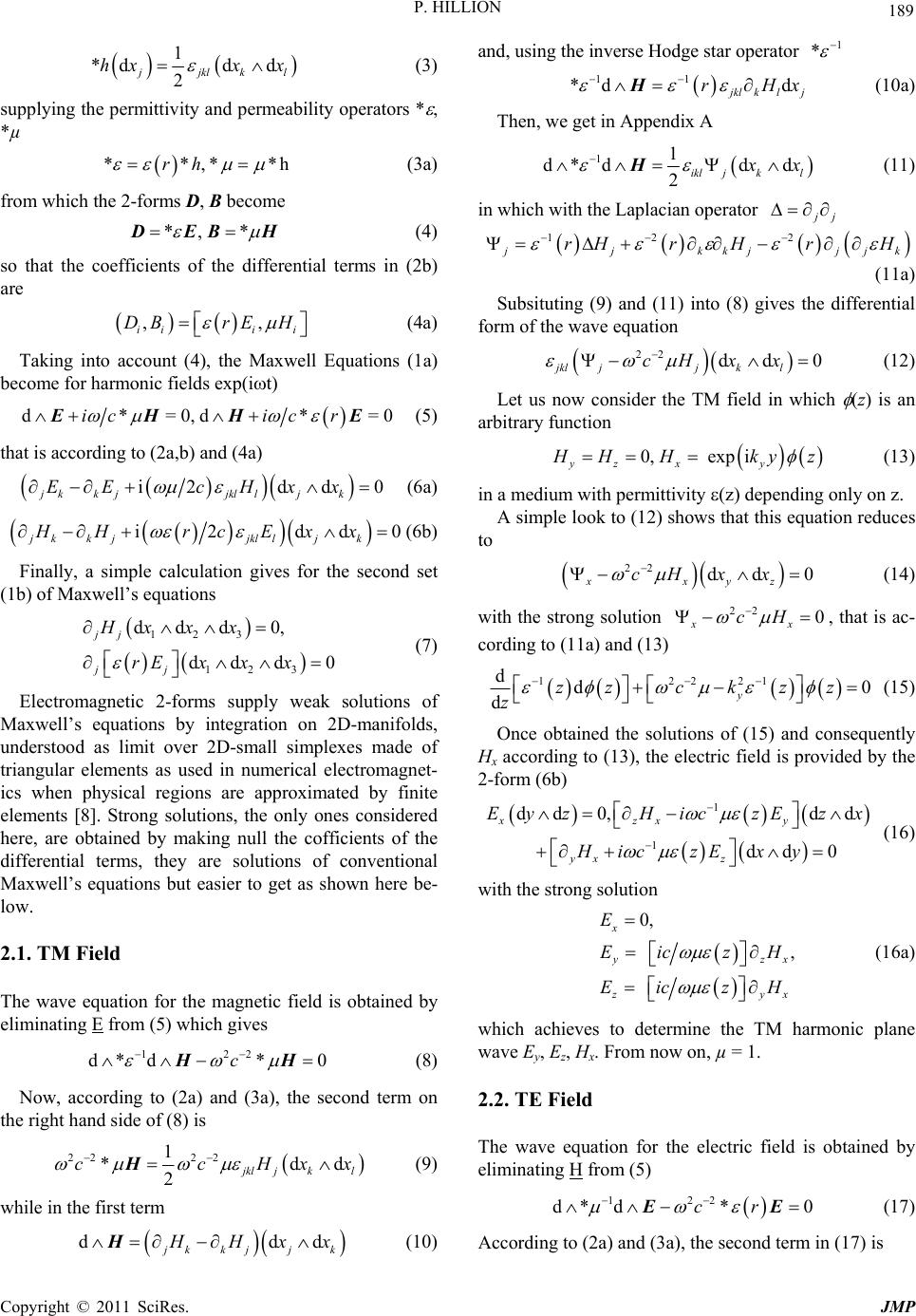 P. HILLION 189 1 *dd d 2 jkl kl hxx x (3) supplying the permittivity and permeability operators * , *µ **,*rh *h (3a) from which the 2-forms D, B become *, * EB H (4) so that the coefficients of the differential terms in (2b) are ,, iii i DBrE H (4a) Taking into account (4), the Maxwell Equations (1a) become for harmonic fields exp(it) d*=0,d *icic r EHH E=0 (5) that is according to (2a,b) and (4a) i2 dd jkk jjklljk EE cHxx 0 (6a) i2 dd jkk jjklljk HH rcExx 0 0 (6b) Finally, a simple calculation gives for the second set (1b) of Maxwell’s equations 123 123 ddd0, ddd jj jj Hx xx rEx xx (7) Electromagnetic 2-forms supply weak solutions of Maxwell’s equations by integration on 2D-manifolds, understood as limit over 2D-small simplexes made of triangular elements as used in numerical electromagnet- ics when physical regions are approximated by finite elements [8]. Strong solutions, the only ones considered here, are obtained by making null the cofficients of the differential terms, they are solutions of conventional Maxwell’s equations but easier to get as shown here be- low. 2.1. TM Field The wave equation for the magnetic field is obtained by eliminating E from (5) which gives 122 d* d*0c HH (8) Now, according to (2a) and (3a), the second term on the right hand side of (8) is 22 22 1 *d 2 d kl jkl ccHx Hx d (9) while in the first term dd kkjj k HxxH (10) and, using the inverse Hodge star operator 1 * 11 *d d kl klj rH Hx (10a) Then, we get in Appendix A 11 d* ddd 2ikl jkl x H (11) in which with the Laplacian operator j 12 2 jkkj jj rHr HrH k (11a) Subsituting (9) and (11) into (8) gives the differential form of the wave equation 22 dd jkl jjkl cH x x 0 (12) Let us now consider the TM field in which (z) is an arbitrary function 0, expi yz xy HH ky z (13) in a medium with permittivity (z) depending only on z. A simple look to (12) shows that this equation reduces to 22 dd xxyz cH x x 0 x (14) with the strong solution 22 0 x cH , that is ac- cording to (11a) and (13) 12221 dd0 dy zz ckzz z (15) Once obtained the solutions of (15) and consequently Hx according to (13), the electric field is provided by the 2-form (6b) 1 1 dd 0,dd dd 0 xzxy yx z EyzHiczE zx HiczE xy (16) with the strong solution 0, , x zx yx E Eic zH Eic zH (16a) which achieves to determine the TM harmonic plane wave Ey, Ez, Hx. From now on, µ = 1. 2.2. TE Field The wave equation for the electric field is obtained by eliminating H from (5) 122 d* d*0cr EE (17) According to (2a) and (3a), the second term in (17) is Copyright © 2011 SciRes. JMP 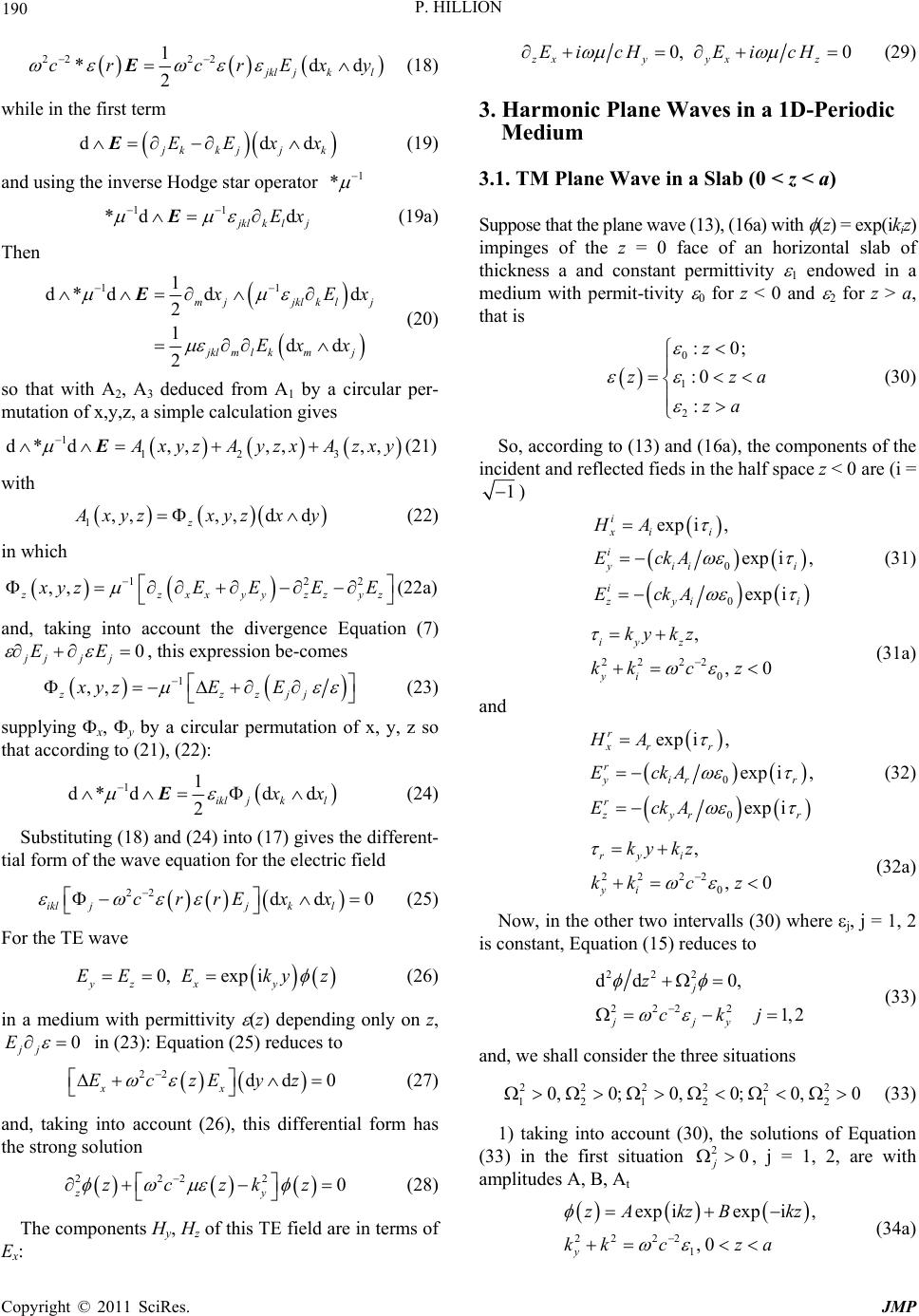 190 P. HILLION 22 22 1 *d 2d kl jkl cr crExy E (18) while in the first term d dd kkjj k EExx E (19) and using the inverse Hodge star operator 1 * 11 *d d kl klj Ex E (19a) Then 11 1 d* ddd 2 1dd 2 mjjklkl j jklmlkmj Ex Ex x E (20) so that with A 2, A3 deduced from A1 by a circular per- mutation of x,y,z, a simple calculation gives 1 123 d* d,,,,,, xyzAyzxAzxy E(21) with 1,,,,d d z xyzxyz x y (22) in which 12 ,, 2 zxx yyzz yz yzE EE E (22a) and, taking into account the divergence Equation (7) 0 jjj j EE this expression be-comes 1 ,, zzz xyzE E jj (23) supplying x y by a circular permutation of x, y, z so that according to (21), (22): 11 d* ddd 2ikl jkl x E (24) Substituting (18) and (24) into (17) gives the different- tial form of the wave equation for the electric field 22 dd ikl jjkl crrExx 0 (25) For the TE wave 0,exp i yz xy EE Ekyz (26) in a medium with permittivity (z) depending only on z, 0 jj E in (23): Equation (25) reduces to 22 dd0 xx EczEyz (27) and, taking into account (26), this differential form has the strong solution 2222 0 zy zczkz (28) The components Hy, Hz of this TE field are in terms of Ex: 0, 0 zxy yxz Ei cHEi cH z a (29) 3. Harmonic Plane Waves in a 1D-Periodic Medium 3.1. TM Plane Wave in a Slab (0 < z < a) Suppose that the plane wave (13), (16a) with (z) = exp(ikiz) impinges of the z = 0 face of an horizontal slab of thickness a and constant permittivity 1 endowed in a medium with permit-tivity 0 for z < 0 and 2 for z > a, that is 0 1 2 :0; :0 : z z za (30) So, according to (13) and (16a), the components of the incident and reflected fieds in the half space z < 0 are (i = 1 ) 0 0 exp i, exp i, exp i i xi i i yii i i yi i HA EckA EckA (31) 22 22 0 , ,0 iy z yi ky kz kkc z (31a) and 0 0 exp i, exp i, exp i r xr r r yir r r yr r HA EckA EckA (32) 22 22 0 , ,0 ry i yi ky kz kkc z (32a) Now, in the other two intervalls (30) where j, j = 1, 2 is constant, Equation (15) reduces to 222 222 2 dd 0, 1, 2 j jjy z ckj (33) and, we shall consider the three situations 222222 121212 0, 0;0, 0;0, 0 (33) 1) taking into account (30), the solutions of Equation (33) in the first situation , j = 1, 2, are with amplitudes A, B, At 20 j 22 22 1 exp iexpi, ,0 y zA kzBkz kk cza (34a) Copyright © 2011 SciRes. JMP 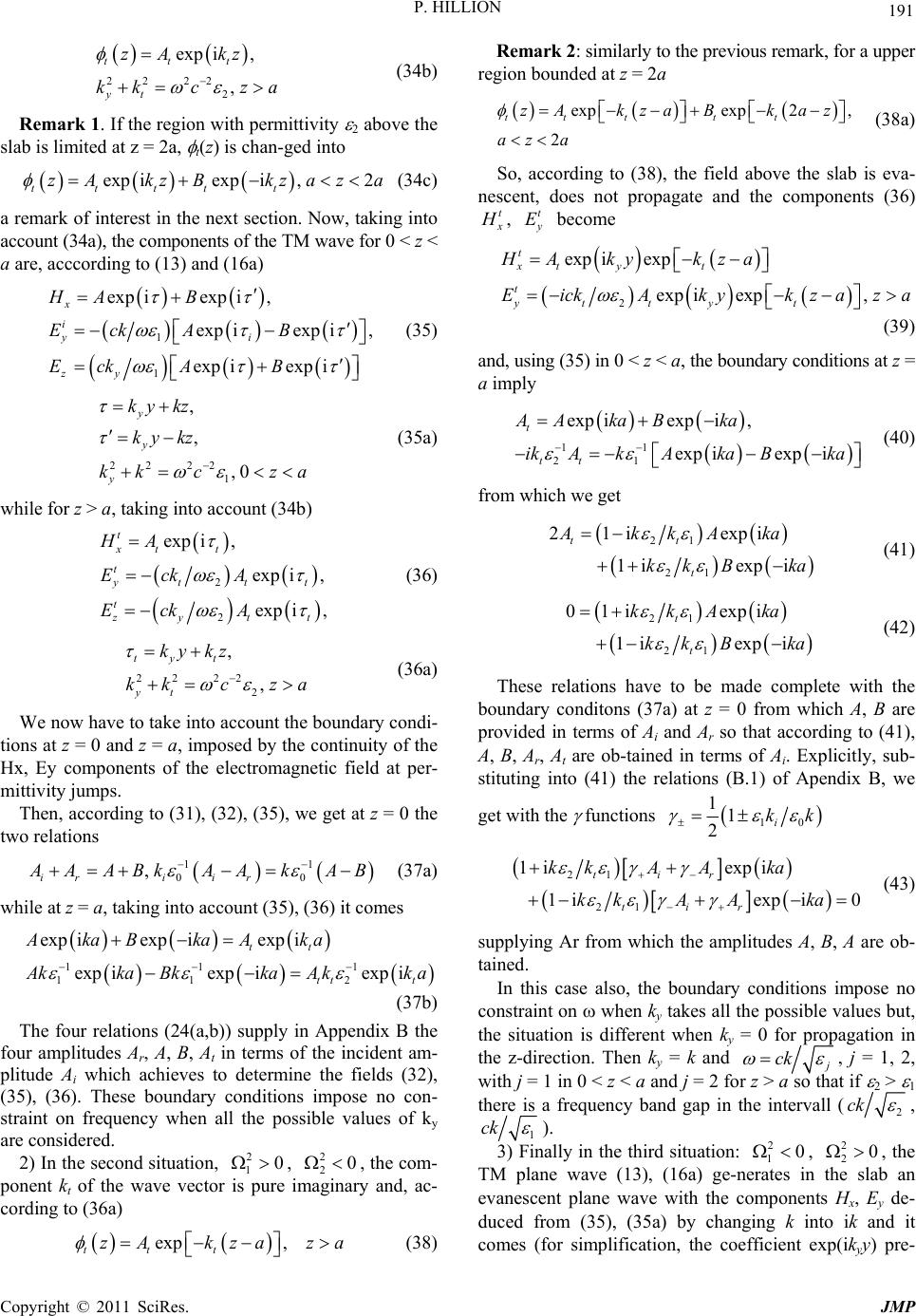 P. HILLION 191 22 22 2 exp i, , ttt yt zA kz kkc za (34b) Remark 1. If the region with permittivity 2 above the slab is limited at z = 2a, t(z) is chan-ged into exp iexpi,2 tttt t zA kzBkzaz a (34c) a remark of interest in the next section. Now, taking into account (34a), the components of the TM wave for 0 < z < a are, acccording to (13) and (16a) 1 1 exp iexpi, exp iexpi, exp iexpi x i yi zy HA B Eck AB Eck AB (35) 22 22 1 , , ,0 y y y ky kz ky kz kk cza (35a) while for z > a, taking into account (34b) 2 2 exp i, exp i, exp i, t xt t t yt t t zy t HA Eck A Eck A t t (36) 22 22 2 , , ty t yt ky kz kkc za (36a) We now have to take into account the boundary condi- tions at z = 0 and z = a, imposed by the continuity of the Hx, Ey components of the electromagnetic field at per- mittivity jumps. Then, according to (31), (32), (35), we get at z = 0 the two relations 11 00 , iriir AABkAA kAB (37a) while at z = a, taking into account (35), (36) it comes 11 1 11 2 exp iexpiexp i exp iexpiexp i tt tt t AkaBkaAka kkaBkkaAk k a (37b) The four relations (24(a,b)) supply in Appendix B the four amplitudes Ar, A, B, At in terms of the incident am- plitude Ai which achieves to determine the fields (32), (35), (36). These boundary conditions impose no con- straint on frequency when all the possible values of ky are considered. 2) In the second situation, 2 10 , , the com- ponent kt of the wave vector is pure imaginary and, ac- cording to (36a) 2 20 exp , tt t zAkzaza Remark 2: similarly to the previous remark, for a upper region bounded at z = 2a expexp 2, 2 tt tt t zAkzaBkaz az a (38a) So, according to (38), the field above the slab is eva- nescent, does not propagate and the components (36) t , t E become 2 exp iexp exp iexp, t xt yt t yttyt HA kykza EickA kykzaz a (39) and, using (35) in 0 < z < a, the boundary conditions at z = a imply 11 21 exp iexpi, exp iexpi t tt AA kaBka ikAkAka Bka (40) from which we get 21 21 21i expi 1iexp i tt t AkkAka kk Bka (41) 21 21 01i expi 1iexpi t t kk Aka kk Bka (42) These relations have to be made complete with the boundary conditons (37a) at z = 0 from which A, B are provided in terms of Ai and Ar so that according to (41), A, B, Ar, At are ob-tained in terms of Ai. Explicitly, sub- stituting into (41) the relations (B.1) of Apendix B, we get with the functions 10 11 2i kk 21 21 1i expi 1iexp i0 tir tir kkAAka kkA Aka (43) supplying Ar from which the amplitudes A, B, A are ob- tained. In this case also, the boundary conditions impose no constraint on when ky takes all the possible values but, the situation is different when ky = 0 for propagation in the z-direction. Then ky = k and ck , j = 1, 2, with j = 1 in 0 < z < a and j = 2 for z > a so that if 2> 1 there is a frequency band gap in the intervall (2 ck , 1 ck ). 3) Finally in the third situation: , , the TM plane wave (13), (16a) ge-nerates in the slab an evanescent plane wave with the components Hx, Ey de- duced from (35), (35a) by changing k into ik and it comes (for simplification, the coefficient exp(ikyy) pre- 2 10 2 20 (38) Copyright © 2011 SciRes. JMP 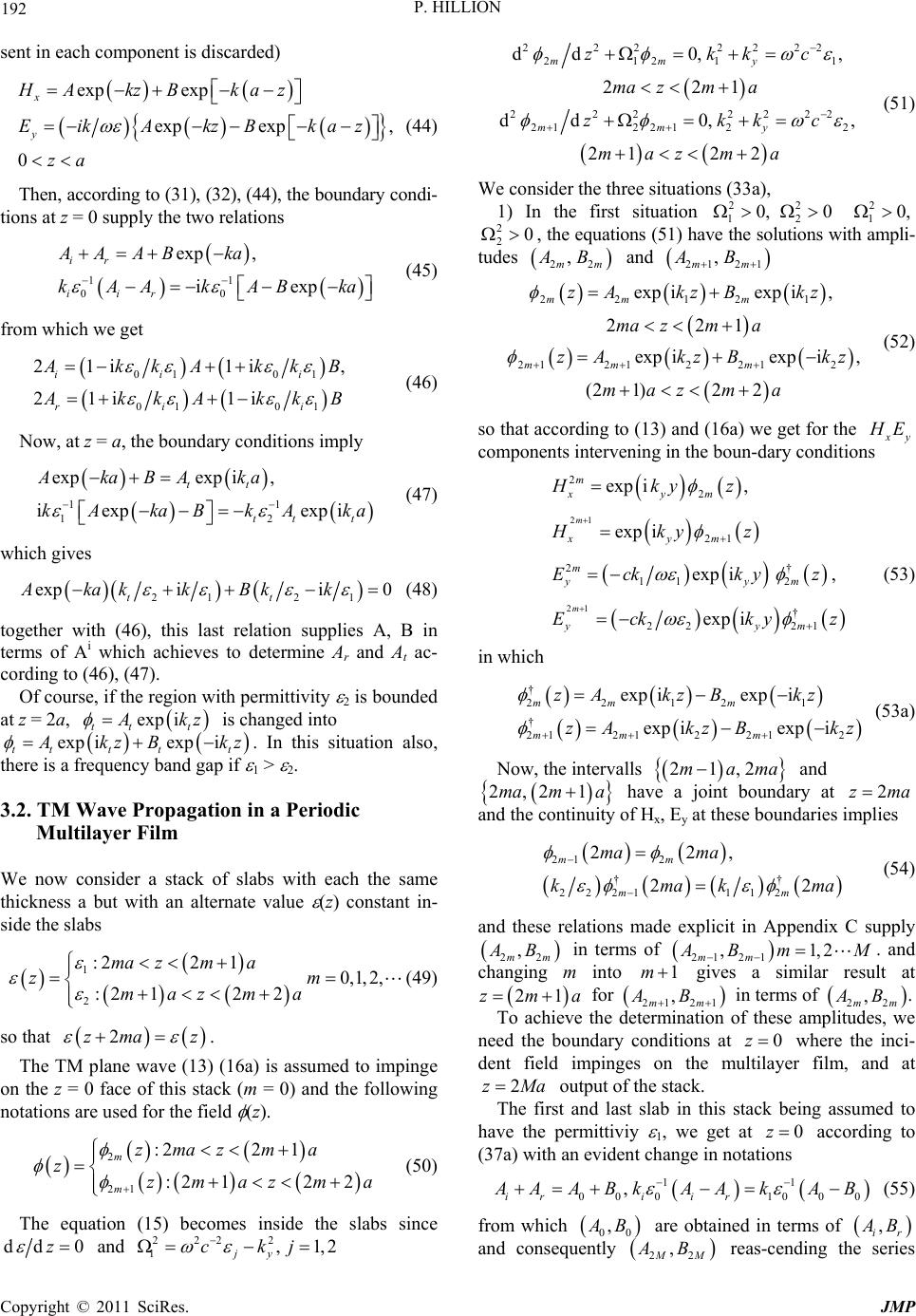 192 P. HILLION sent in each component is discarded) exp exp exp exp, 0 x y HA kzBkaz EikA kzBkaz za (44) Then, according to (31), (32), (44), the boundary condi- tions at z = 0 supply the two relations 11 00 exp , iexp ir iir AA ABka kAA kABka (45) from which we get 01 01 01 01 21i1i 21i 1i ii i ri i , kkAkk B kkAkk B (46) Now, at z = a, the boundary conditions imply 11 12 expexp i, iexp expi tt tt t AkaBAka kAkaBkA ka (47) which gives 21 21 expii 0 tt Akak kBk k (48) together with (46), this last relation supplies A, B in terms of Ai which achieves to determine Ar and At ac- cording to (46), (47). Of course, if the region with permittivity 2 is bounded at z = 2a, exp i ttt kz p iexpi is changed into ex ttttt kz Bkz m a . In this situation also, there is a frequency band gap if 1 > 2. 3.2. TM Wave Propagation in a Periodic Multilayer Film We now consider a stack of slabs with each the same thickness a but with an alternate value z) constant in- side the slabs 1 2 :2210,1, 2, :2 122 ma zma z mazma (49) so that . 2zma z The TM plane wave (13) (16a) is assumed to impinge on the z = 0 face of this stack (m = 0) and the following notations are used for the field (z). 2 21 :221 :2 122 m m zmazm a zzmazm (50) The equation (15) becomes inside the slabs since dd 0z and 222 2 1,1, jy ckj 2222222 2121 222 2222 21221 22 dd 0,, 221 dd 0, 2122 mmy mmy zkkc ma zma zkk maz m a 1 ,c (51) We consider the three situations (33a), 1) In the first situation 22 12 0, 0 2 10, 2 20 , the equations (51) have the solutions with ampli- tudes 22 , mm AB and 21 21 , mm AB 22121 21212 212 exp iexpi, 221 exp iexpi, (2 1)22 mmm mmm zA kzBkz ma zma zA kzBkz mazm a (52) so that according to (13) and (16a) we get for the y E components intervening in the boun-dary conditions 2 2 exp i, m xym ky z 21 21 exp i m xym ky z 2 11 exp i m yy ky † 2mz Eck , (53) 21 † 22 21 exp i m yy Eck ky m z in which † 22121 † 21212 212 exp iexpi exp iexpi mm m mm m zA kzBkz zA kzBkz (53a) Now, the intervalls 21,2mama and 2,2 1ma ma have a joint boundary at 2zma and the continuity of Hx, Ey at these boundaries implies 21 2 †† 2221112 22, 22 mm mm ma ma kmak ma (54) and these relations made explicit in Appendix C supply 22 , mm AB in terms of 21 21 ,1,2 mm Bm M 1 . and changing m into m gives a similar result at 2zm1a for 21 21 , mm AB in terms of 22mm , B. To achieve the determination of these amplitudes, we need the boundary conditions at where the inci- dent field impinges on the multilayer film, and at 0z 2zM a output of the stack. The first and last slab in this stack being assumed to have the permittiviy 1, we get at according to (37a) with an evident change in notations 0z 11 00 01000 , iri ir AABkAAkAB (55) from which 00 , B are obtained in terms of , ir B and consequently 22 , MM AB reas-cending the series 2 Copyright © 2011 SciRes. JMP 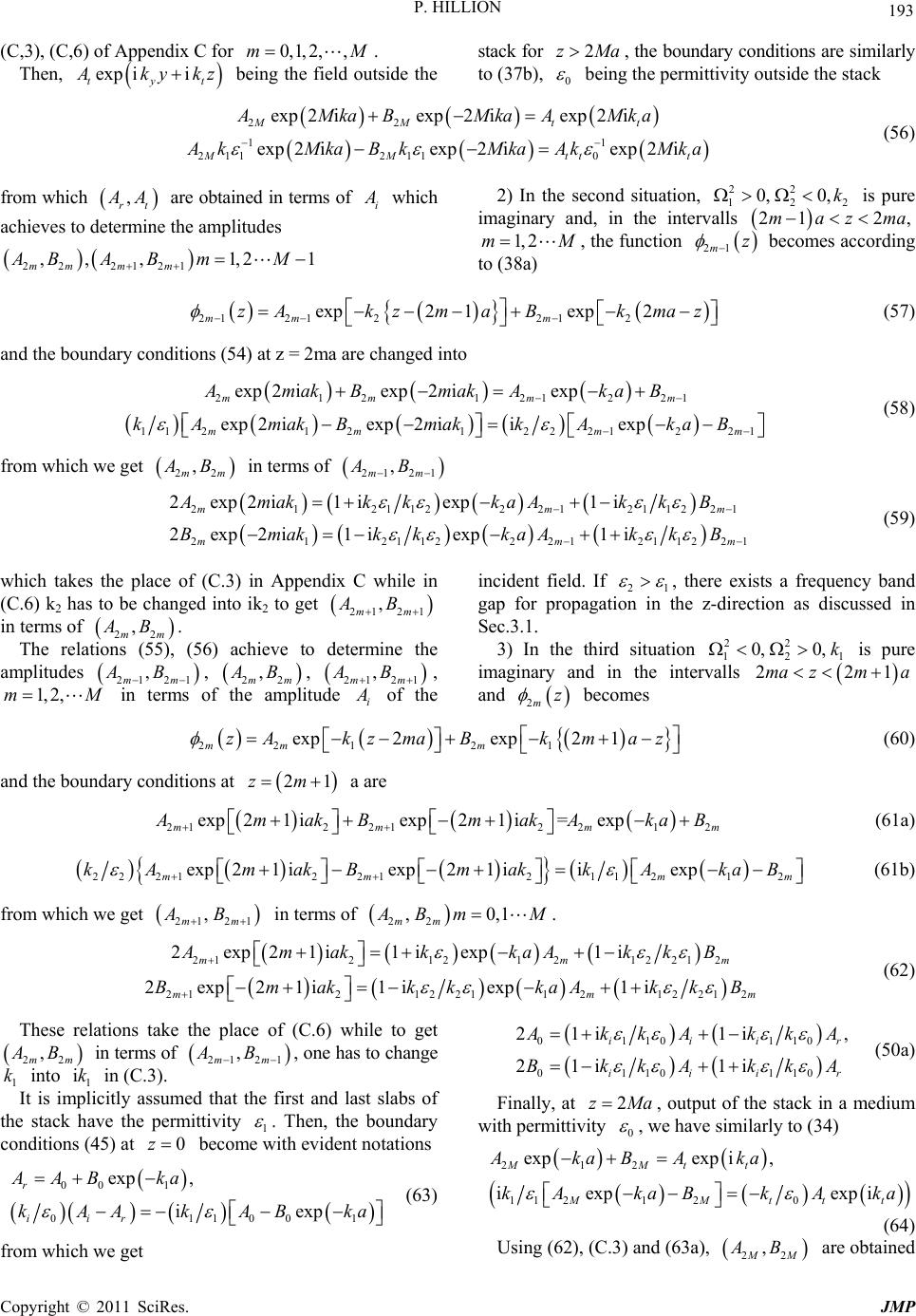 P. HILLION Copyright © 2011 SciRes. JMP 193 t (C,3), (C,6) of Appendix C for . 0,1, 2,,mM Then, exp ii ty ky kz being the field outside the stack for , the boundary conditions are similarly to (37b), 2zM 0 a being the permittivity outside the stack 22 11 21 2110 exp2 iexp2 i exp2iexp2i MM tt MMtt aB MkaAMka 1 exp 2i exp 2i AMk t kMkaBkMkaAkM ka (56) from which , rt A are obtained in terms of 2) In the second situation, is pure imaginary and, in the intervalls 22 12 0,0, k 21ma 2 2zma i which achieves to determine the amplitudes , M1, 2m , the function 21mz becomes according to (38a) 222121 ,, , mmm m ABA Bm 1,2 1M 212212 2 1exp2 m kzm aBkmaz 21 exp mm zA (57) and the boundary conditions (54) at z = 2ma are changed into 2 121221 11212 221221 exp2 iexp expxp2 iiexp mm mm Am akAkaB kAmak k AkaB 21 1 2 exp 2i 2 ie mm mm m akB makB (58) from which we get in terms of 22 , mm AB 21 21 , mm AB 2112221211221 2112221211221 2eexp 1i 2ei exp1i mm mmm kkkaAkkB kkkaA kkB 21 21 xp2i 1i xp2i1 m Amak Bmak 21 22 , mm AB 21 , m i (59) which takes the place of (C.3) in Appendix C while in (C.6) k2 has to be changed into ik2 to get in terms of . 21 , mm AB 22 , mm AB The relations (55), (56) achieve to determine the amplitudes , , 21m , in terms of the amplitude 21 21 , mm AB M AB 1, 2,m of the incident field. If 21 , there exists a frequency band gap for propagation in the z-direction as discussed in Sec.3.1. 3) In the third situation is pure imaginary and in the intervalls 22 12 0,0, k 1 m a22ma z1 and 2mz becomes 12 1 2exp21 m zmaBkm az 22 exp mm zA k (60) and the boundary conditions at a are 21zm 2112212 expexp21 i=exp m 2 2 21 i mm mak m BmakA kaB (61a) 22 211211 212 exp2exp21 iiexp mm kAmakkAkaB 2 2 1 i mm makB 1m (61b) from which we get in terms of 21 2 , m AB 22 ,0,1 mm Bm M. 21121212 212 211221121221 2 2e1iexp 1i 2exp1 iexp1 i mm mmm kkkaAkkB kkkkaAkkB 2 2 xp21i 21 i m Ama Bma 21 , mm AB (62) 0110 110 0110 110 21i1i 21i 1i iii iii These relations take the place of (C.6) while to get in terms of , one has to change into i in (C.3). 22 , mm AB 1 k k 21 , r r kk Akk A BkkAkk A a (50a) 1 It is implicitly assumed that the first and last slabs of the stack have the permittivity 1 Finally, at 2zM , output of the stack in a medium with permittivity 0 , we have similarly to (34) . Then, the boundary conditions (45) at become with evident notations 0z 100 ie xpAB k 00 1 01 1 exp , r iir AAB ka kAA ka 212 11 2120 expexp i, iexp expi MMtt MMtt AkaBAka kAkaBkA ka t (64) (63) Using (62), (C.3) and (63a), are obtained 22 , MM AB from which we get 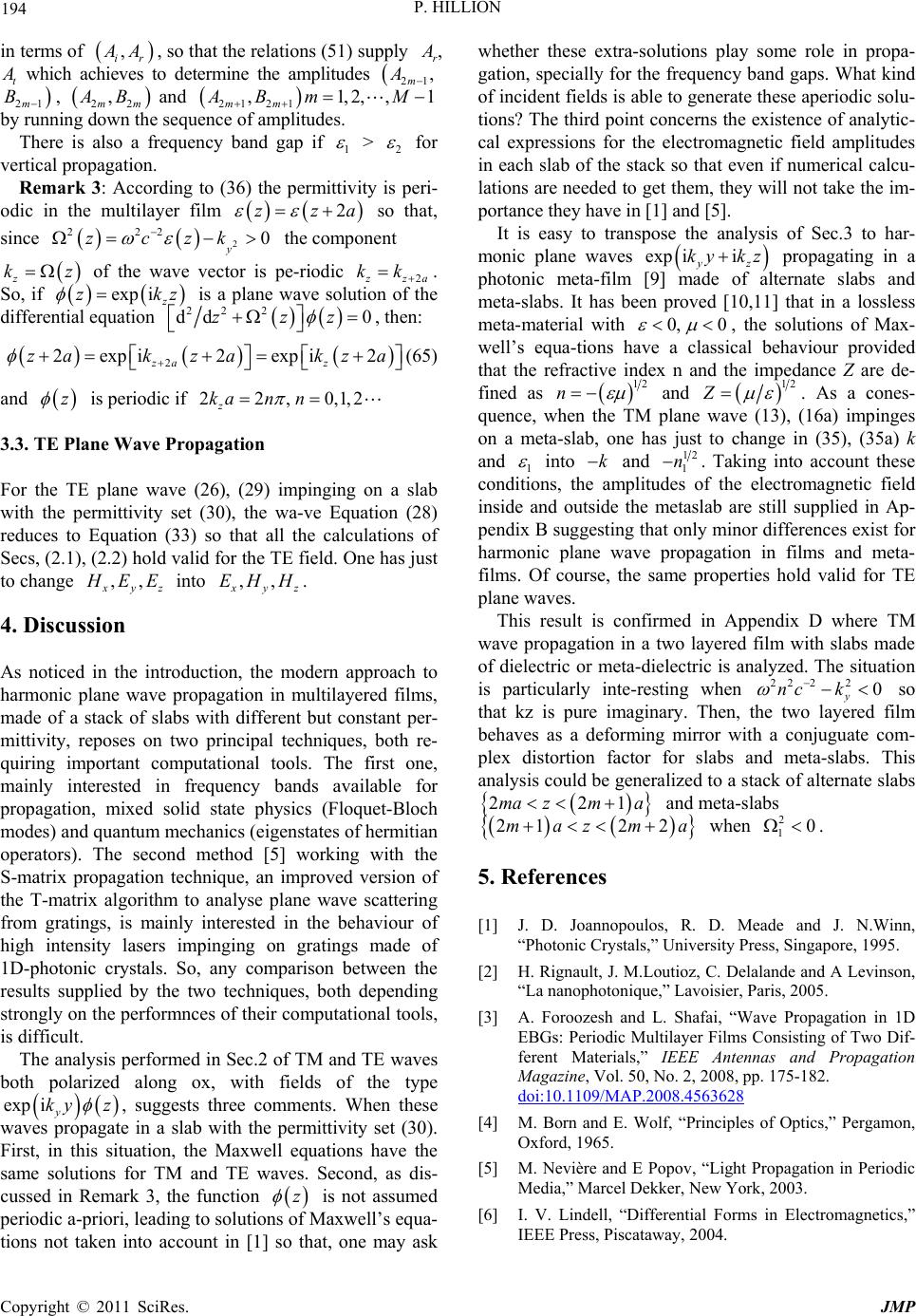 194 P. HILLION in terms of , ir A, so that the relations (51) supply r , t which achieves to determine the amplitudes 21 , m A , 21m B 22 , mm B and mm by running down the sequence of amplitudes. 21 21 ,1AB m 1 ,2,,M1 There is also a frequency band gap if > 2 for vertical propagation. Remark 3: According to (36) the permittivity is peri- odic in the multilayer film so that, 2zz 2 20 y zk a since the component 22 zc z z of the wave vector is pe-riodic 2 k za kk . So, if is a plane wave solution of the differential equation exp iz z kz 22 2 dd 0zz z , then: za z 22 expi za z zakz 2expik 2a 2 (65) and is periodic if 22,0,1, z kan n 3.3. TE Plane Wave Propagation For the TE plane wave (26), (29) impinging on a slab with the permittivity set (30), the wa-ve Equation (28) reduces to Equation (33) so that all the calculations of Secs, (2.1), (2.2) hold valid for the TE field. One has just to change ,, yz EE into ,, yz EHH. 4. Discussion As noticed in the introduction, the modern approach to harmonic plane wave propagation in multilayered films, made of a stack of slabs with different but constant per- mittivity, reposes on two principal techniques, both re- quiring important computational tools. The first one, mainly interested in frequency bands available for propagation, mixed solid state physics (Floquet-Bloch modes) and quantum mechanics (eigenstates of hermitian operators). The second method [5] working with the S-matrix propagation technique, an improved version of the T-matrix algorithm to analyse plane wave scattering from gratings, is mainly interested in the behaviour of high intensity lasers impinging on gratings made of 1D-photonic crystals. So, any comparison between the results supplied by the two techniques, both depending strongly on the performnces of their computational tools, is difficult. The analysis performed in Sec.2 of TM and TE waves both polarized along ox, with fields of the type , suggests three comments. When these waves propagate in a slab with the permittivity set (30). First, in this situation, the Maxwell equations have the same solutions for TM and TE waves. Second, as dis- cussed in Remark 3, the function is not assumed periodic a-priori, leading to solutions of Maxwell’s equa- tions not taken into account in [1] so that, one may ask whether these extra-solutions play some role in propa- gation, specially for the frequency band gaps. What kind of incident fields is able to generate these aperiodic solu- tions? The third point concerns the existence of analytic- cal expressions for the electromagnetic field amplitudes in each slab of the stack so that even if numerical calcu- lations are needed to get them, they will not take the im- portance they have in [1] and [5]. ky z exp i y z It is easy to transpose the analysis of Sec.3 to har- monic plane waves exp ii yz ky kz 0, 0 propagating in a photonic meta-film [9] made of alternate slabs and meta-slabs. It has been proved [10,11] that in a lossless meta-material with , the solutions of Max- well’s equa-tions have a classical behaviour provided that the refractive index n and the impedance Z are de- fined as 12 n and 12 Z . As a cones- quence, when the TM plane wave (13), (16a) impinges on a meta-slab, one has just to change in (35), (35a) k and 1 into k and 12 1 n. Taking into account these conditions, the amplitudes of the electromagnetic field inside and outside the metaslab are still supplied in Ap- pendix B suggesting that only minor differences exist for harmonic plane wave propagation in films and meta- films. Of course, the same properties hold valid for TE plane waves. This result is confirmed in Appendix D where TM wave propagation in a two layered film with slabs made of dielectric or meta-dielectric is analyzed. The situation is particularly inte-resting when so that kz is pure imaginary. Then, the two layered film behaves as a deforming mirror with a conjuguate com- plex distortion factor for slabs and meta-slabs. This analysis could be generalized to a stack of alternate slabs 22 220 y nc k 221ma zma and meta-slabs 2a21 2mazm when . 2 10 5. References [1] J. D. Joannopoulos, R. D. Meade and J. N.Winn, “Photonic Crystals,” University Press, Singapore, 1995. [2] H. Rignault, J. M.Loutioz, C. Delalande and A Levinson, “La nanophotonique,” Lavoisier, Paris, 2005. [3] A. Foroozesh and L. Shafai, “Wave Propagation in 1D EBGs: Periodic Multilayer Films Consisting of Two Dif- ferent Materials,” IEEE Antennas and Propagation Magazine, Vol. 50, No. 2, 2008, pp. 175-182. doi:10.1109/MAP.2008.4563628 [4] M. Born and E. Wolf, “Principles of Optics,” Pergamon, Oxford, 1965. [5] M. Nevière and E Popov, “Light Propagation in Periodic Media,” Marcel Dekker, New York, 2003. [6] I. V. Lindell, “Differential Forms in Electromagnetics,” IEEE Press, Piscataway, 2004. Copyright © 2011 SciRes. JMP 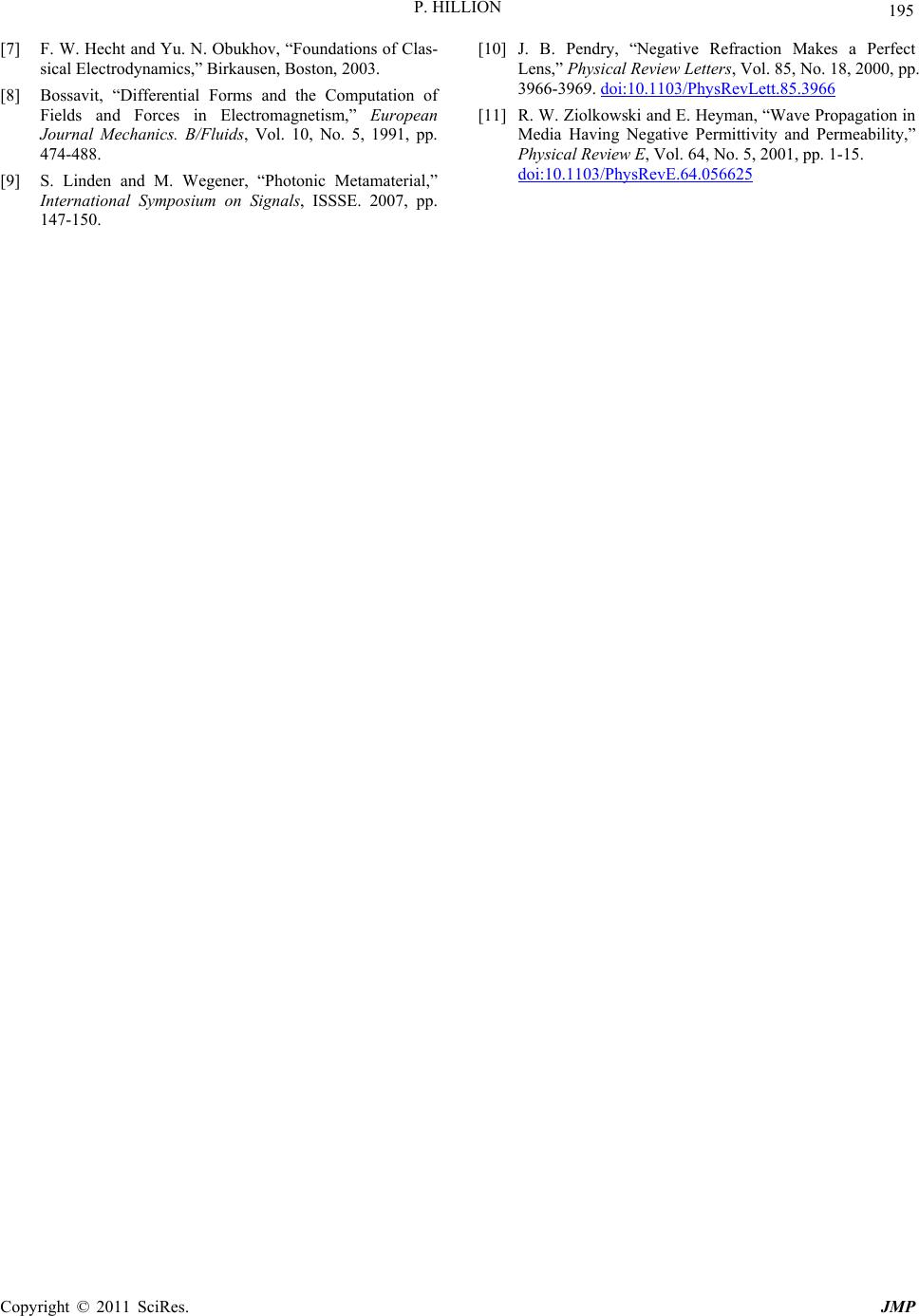 P. HILLION Copyright © 2011 SciRes. JMP 195 [7] F. W. Hecht and Yu. N. Obukhov, “Foundations of Clas- sical Electrodynamics,” Birkausen, Boston, 2003. [8] Bossavit, “Differential Forms and the Computation of Fields and Forces in Electromagnetism,” European Journal Mechanics. B/Fluids, Vol. 10, No. 5, 1991, pp. 474-488. [9] S. Linden and M. Wegener, “Photonic Metamaterial,” International Symposium on Signals, ISSSE. 2007, pp. 147-150. [10] J. B. Pendry, “Negative Refraction Makes a Perfect Lens,” Physical Review Letters, Vol. 85, No. 18, 2000, pp. 3966-3969. doi:10.1103/PhysRevLett.85.3966 [11] R. W. Ziolkowski and E. Heyman, “Wave Propagation in Media Having Negative Permittivity and Permeability,” Physical Review E, Vol. 64, No. 5, 2001, pp. 1-15. doi:10.1103/PhysRevE.64.056625 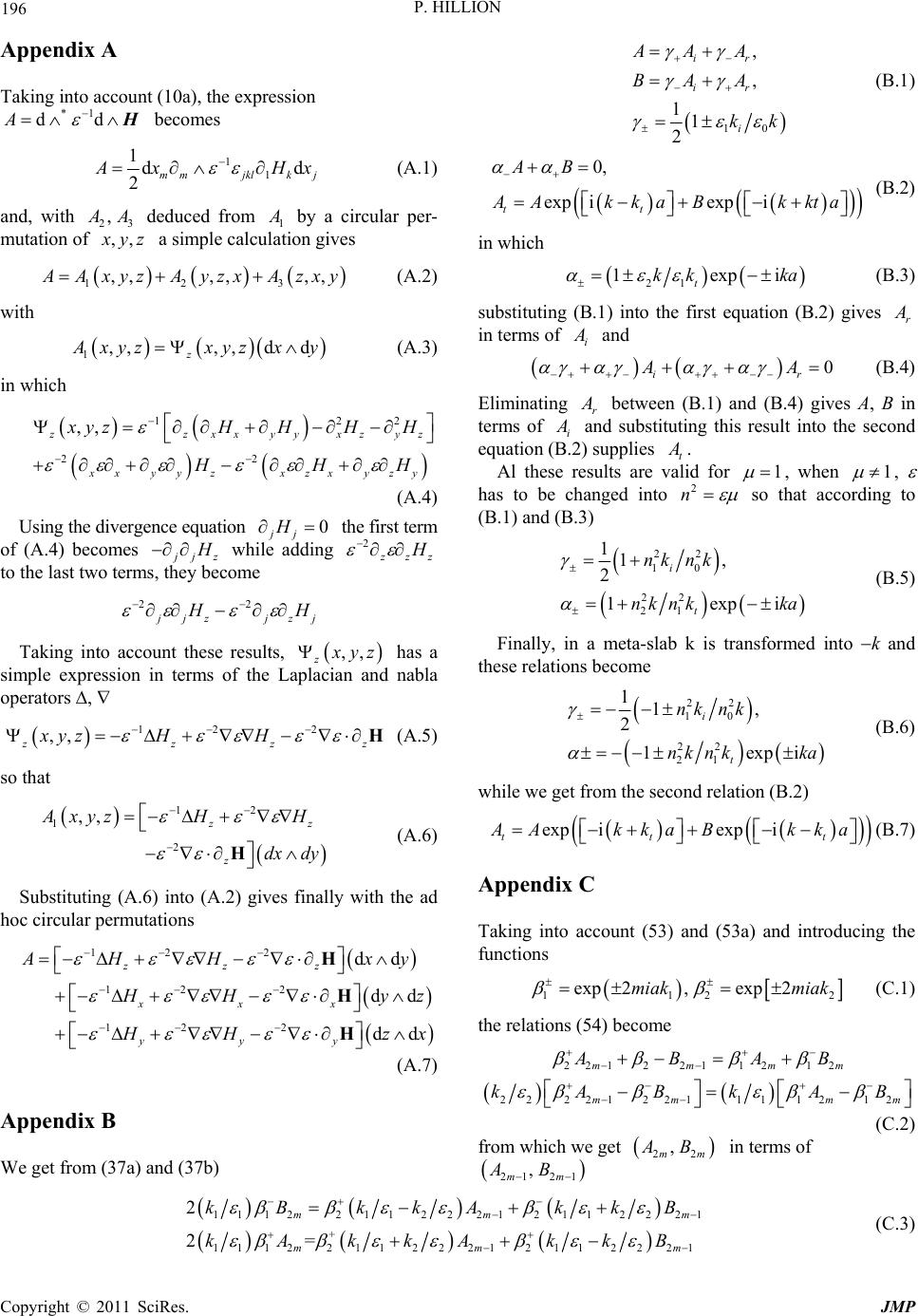 196 P. HILLION Appendix A Taking into account (10a), the expression *1 ddA becomes 1 1 1d 2mmjklk j d x Hx (A.1) and, with 23 , A deduced from 1 by a circular per- mutation of ,, yz a simple calculation gives 123 ,,,, ,, AxyzAyzxAzxy (A.2) with 1,,,,d d z xyzxyz x y (A.3) in which 12 22 ,, 2 zxx yyxz yz xxyy zxzxyzy yzH HHH HH H (A.4) Using the divergence equation the first term of (A.4) becomes 0 jj H jz while adding 2 zz to the last two terms, they become 22 jzj zj H Taking into account these results, ,, z yz has a simple expression in terms of the Laplacian and nabla operators ∆, 12 2 ,, zzz xyz HH H z (A.5) so that 12 1 2 ,, z z Axyz HH dx dy H (A.6) Substituting (A.6) into (A.2) gives finally with the ad hoc circular permutations 12 2 12 2 12 2 dd dd dd zzz xxx yyy HH xy Hyz H H H Hzx (A.7) Appendix B We get from (37a) and (37b) 10 , , 11 2 ir ir i AAA BAA kk (B.1) 0, exp iexpi tt AB AkkaBkkta (B.2) in which 21 1exp t kk ka i (B.3) substituting (B.1) into the first equation (B.2) gives r in terms of i and 0 ir AA (B.4) Eliminating r between (B.1) and (B.4) gives A, B in terms of i and substituting this result into the second equation (B.2) supplies t . Al these results are valid for 1 , when 1 , has to be changed into 2 n so that according to (B.1) and (B.3) 22 10 22 21 11, 2 1exp i t nknk nk nkka i (B.5) Finally, in a meta-slab k is transformed into k and these relations become 22 10 22 21 11, 2 1exp i t nknk nk nkka i (B.6) while we get from the second relation (B.2) exp iexpi tt t Ak kaBk ka (B.7) Appendix C Taking into account (53) and (53a) and introducing the functions 112 exp2,exp 2miak miak 2 (C.1) the relations (54) become 2212211212 22221 22111 1212 mmmm mm m ABAB kABkAB m (C.2) from which we get 22 , mm AB in terms of 21 21 , mm AB 11122112 2212112221 + 11122112 2212112221 2 2= mm mm kB kkAkkB kAkkAkkB m m (C.3) Copyright © 2011 SciRes. JMP  P. HILLION Copyright © 2011 SciRes. JMP 197 a Similarly, according to (52) and (53a), the boundary conditions at are 21zm 1212221 221 111211212 22222 mm mm mmm AB AB kABkA A in which m (C.4) 1 22 exp21 i, exp21 i mak mak 1 (C.5) The relation (C.4) supplies in terms of 21 21 , mm AB 22 , mm AB 222211 112221 11222 222211 1122 21 11222 2 2 mm mm kA kkAkk kB kkAkk m m B B (C.6) Appendix D TM wave propagation in a two layered film We consider the propagation of a TM harmonic plane wave in a two layered film made of two slabs of thick- ness a with permittivity-permeability couples 00 , outside the film, 112 2 ,,, in the first and second slab respectively. Then, the refractive index 12 0,1, 2j jj n j, the plus sign for 0 j , 0 j , the minus sign for 0, jj 0 . For the TM wave (13), (16a), the components , E of the electromagnetic field have the expressions (31)-(36) in which we use the following notations 12 12 22 22 , , 1, y knc n kc n vn (D.1) being either positive or pure imaginary. In addition, the coeffficient that appears in each com- ponent is deleted. Different situations exist according that exp iy ky is real or not and n positive implying , or negative with . 0k 0v0, 0v 0n k 0, Then, assuming jj , , y E have the following expressions (j = 0, 1, 2) 00 0, i zkn 00 exp i,expi 1exp i,1expi ir xixri ir yiiyr HAkz HAkz EvAkzEvA k i z (D.2) 111 0,zakn c : incident and reflected fields 1 111 1 1 111 11 exp iexpi 1exp iexpi x y HA kzBkz EvAkzB kz (D.3) 222 2,azaknc : field in the second slab 2 2222 2 222 22 exp iexpi 1expi expi x y HA kzBkz EvAkzBkz (D.4) 00 2,zakt nc : field above the two layered film 0 exp i, 1expi t xt t t yt HA kz EvAk t z a (D.5) The boundary conditions at , give the following relations between the 0,,2zzaz the amplitudes A 0z : 1 11 011 , 11 ir ir AA AB vAAvA B (D.6) a : c : incident and reflected fields 11112222 111112 2222 exp iexpiexpiexpi 1exp iexpi1exp iexpi AkaBka AkaBka vAkaBkavAka Bka (D.7) 2za: 222 2 222 220 exp 2iexp2iexp 2i 1exp iexpi1exp i tt tt AkaBkaAka vAka BkavAka (D.8) The fields (D.3), (D.4) are invariant under the inver- sions corres-ponding to the exchange slab meta-slab so that it does not matter whether the slabs are made of dielectric or meta-dielec- tric, the solutions of the equations (D.6)-(D.8) will be the same in any case. ,, ,,,,knABk nBA We get at once from (D.8) in terms of an arbitrary am- plitude X 222 202 2 exp i, exp i vv kaX BvvkaX (D.9) S ubstituting (D.9) into (D.7) gives 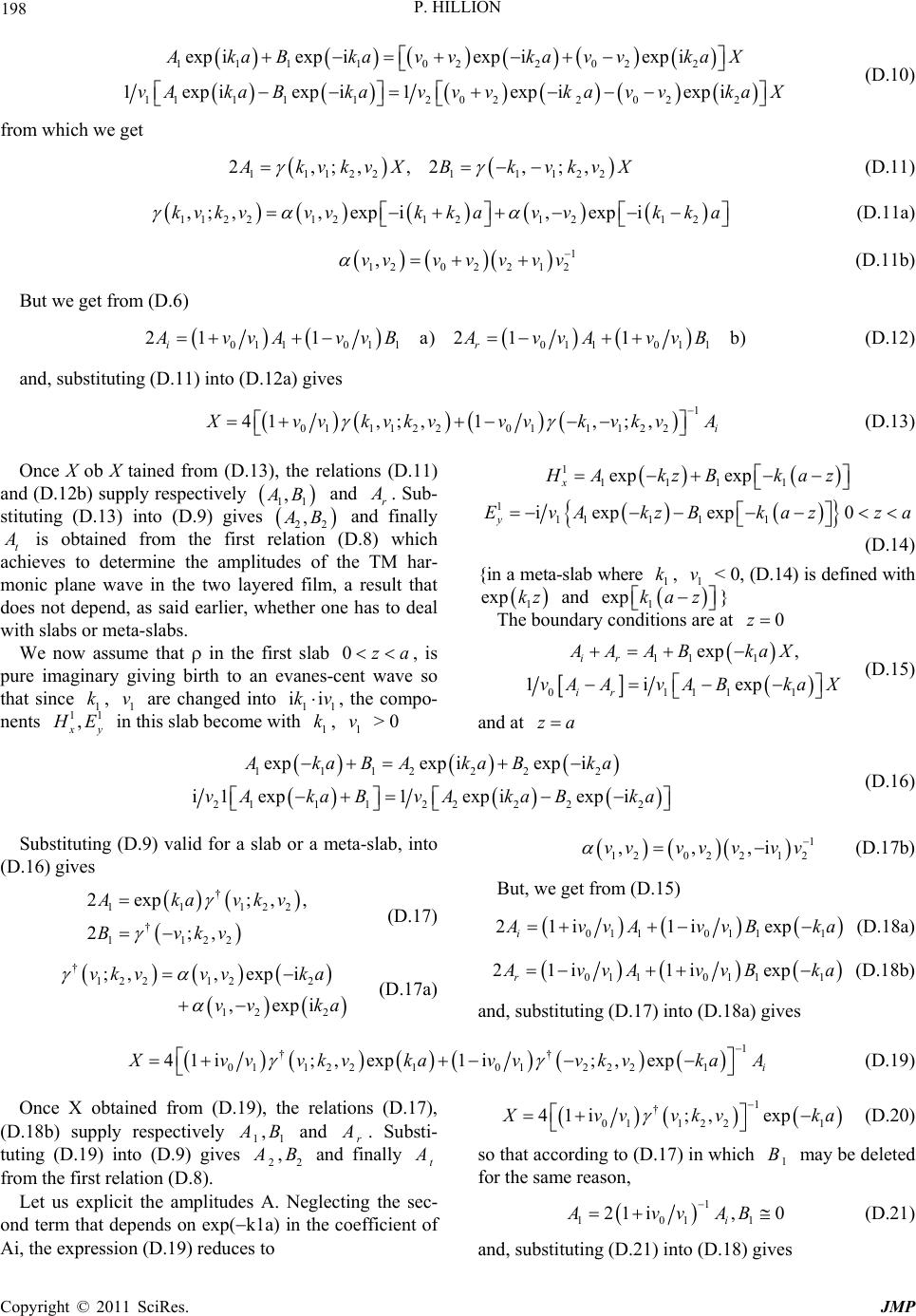 198 P. HILLION 1111 022022 1111120220 22 exp iexpiexpiexp i 1exp iexpi1expiexp i AkaBkavvkavv kaX vAkaBkavvvkavvkaX (D.10) from which we get 111221 1122 2,;,,2 ,;, kvk vXBkvkvX (D.11) 11 2 212121212 ,; ,,expi,expikvkvvvkk avvkk a (D.11a) 1 120221 2 ,vvvvvv v (D.11b) But we get from (D.6) 01 101 101 101 1 211 a)211 b ir AvvA vvBAvvA vvB ) (D.12) and, substituting (D.11) into (D.12a) gives 1 011122011 122 41,;,1,; ,i vvkvkvvvkvkvA (D.13) Once X ob X tained from (D.13), the relations (D.11) and (D.12b) supply respectively 11 , B and r . Sub- stituting (D.13) into (D.9) gives 2 2 , B and finally t is obtained from the first relation (D.8) which achieves to determine the amplitudes of the TM har- monic plane wave in the two layered film, a result that does not depend, as said earlier, whether one has to deal with slabs or meta-slabs. We now assume that in the first slab , is pure imaginary giving birth to an evanes-cent wave so that since , 1 are changed into 11 , the compo- nents 0za v 1 k 1 , viik 1 y E in this slab become with , > 0 1 k1 v 1 1111 1 11111 exp exp iexpexp0 x y HA kzBkaz EvAkzBkazz a (D.14) {in a meta-slab where , < 0, (D.14) is defined with 1 k1 v 1 exp kz and z 1 exp ka } The boundary conditions are at 0z 11 1 01111 exp , 1iexp ir ir AA ABkaX vAAvABkaX (D.15) and at za 1112222 211122222 expexp iexpi i1exp1exp iexpi AkaBAkaBka vAkaB vAkaBka (D.16) Substituting (D.9) valid for a slab or a meta-slab, into (D.16) gives † 1112 † 1122 2exp ;, 2;, 2 , kav kv Bvkv (D.17) † 122 122 12 2 ;,,expi ,expi vk vvvka vv ka 1 120221 2 ,,,ivvvvvv v (D.17b) But, we get from (D.15) 01 101 11 21i1i exp i vvAvvB ka (D.18a) 01 101 11 21i1iexp r vvAvvBka (D.18b) (D.17a) and, substituting (D.17) into (D.18a) gives 1 †† 01 1221012221 41i;,exp1i; ,expi vvvkvkavvvkvka A (D.19) Once X obtained from (D.19), the relations (D.17), (D.18b) supply respectively 11 , B and r . Substi- tuting (D.19) into (D.9) gives 2 ,2 B and finally t from the first relation (D.8). Let us explicit the amplitudes A. Neglecting the sec- ond term that depends on exp(k1a) in the coefficient of Ai, the expression (D.19) reduces to 1 † 01 1221 41i;,exp vv vkvka (D.20) so that according to (D.17) in which may be deleted for the same reason, 1 B 1 1011 21 i,0 i AvvAB (D.21) and, substituting (D.21) into (D.18) gives Copyright © 2011 SciRes. JMP 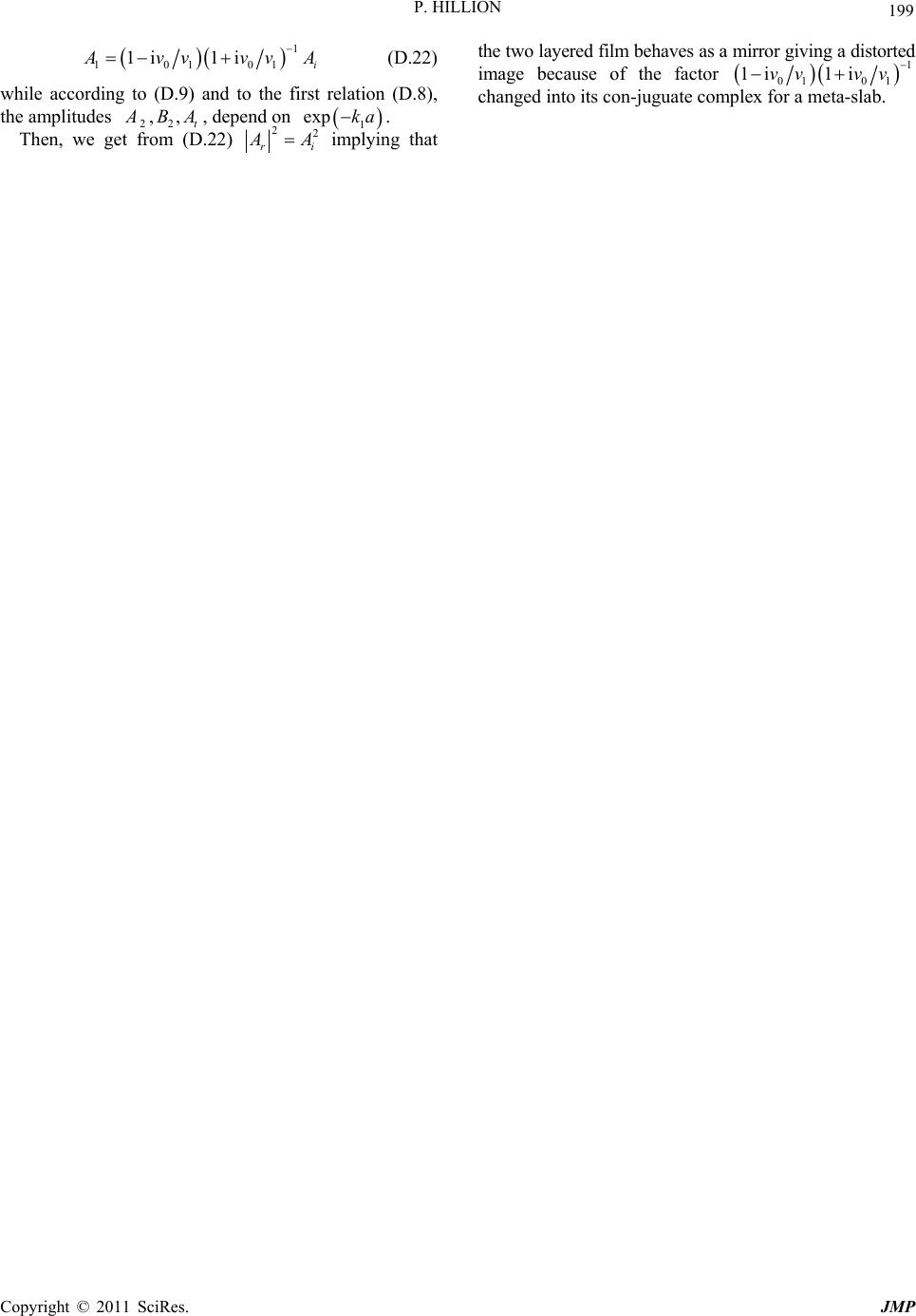 P. HILLION 199 1 10101 1i 1ii vvvv A (D.22) while according to (D.9) and to the first relation (D.8), the amplitudes 22 ,, t BA, depend on 1 exp ka. Then, we get from (D.22) 22 ri implying that the two layered film behaves as a mirror giving a distorted image because of the factor 1 01 01 1i 1ivv vv changed into its con-juguate complex for a meta-slab. A Copyright © 2011 SciRes. JMP
|